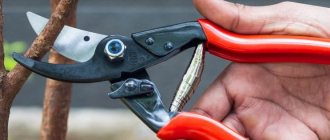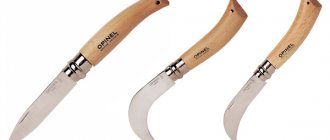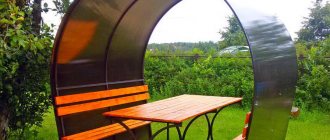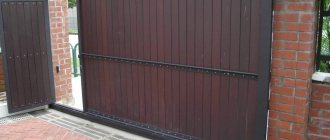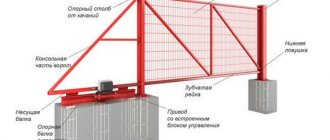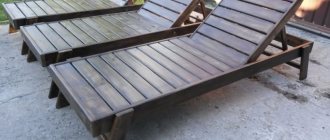A garden pruner is a hand tool that resembles large scissors both in appearance and in its operating principle. But there are many types of such equipment: some are designed exclusively for trimming flowers and young shoots, others cope with thick branches better than a hand saw. It is difficult for an inexperienced summer resident to understand all the subtleties. So for those who are just planning to improve their plot, it will be useful to know what types of pruners are used for certain jobs, and how to choose the right tool for themselves.
What kind of instrument is this?
This is a type of gardening tool with a specific shape, the purpose of which is to obtain an even cut on branches and stems that differ in their shape and thickness. A good pruner should be sharp enough and precise in operation. In its shape it resembles curved scissors, but has one sharp blade. Its second part is the counter blade, designed to support the branches when cutting them.
Expert opinion
Kuznetsov Vasily Stepanovich
Thanks to this design, an even cut is ensured with minimal damage to the plant bark. This is important for quick healing of cut branches.
Sharpening
A sharpened blade made of good steel gives a beautiful, even cut, but sooner or later, it will still become dull. Sometimes the effect of a dull blade appears when a lot of juice has dried on it - you just need to wash it off with a warm disinfectant solution. If this does not help, then sharpening is required.
In the simplest version, you can sharpen the pruning shears with a file, but for a high-quality tool it is advisable to stock up on diamond stones. To prevent metal filings from clogging the abrasive, it is slightly moistened with water when working.
Start with the coarsest whetstone, sliding it along the blade from the handle to the sharp end, trying not to change its sharpening angle, which is usually 10–20°. Sharpen from the side opposite to the plane of contact of the blades, without touching it. The medium-sized bar is used to bring it to the desired sharpness, and the smallest one is used to remove burrs, including from the side where the blades touch.
Kinds
Due to the fact that all types of plants have different rigidity, thickness and texture, the types of pruning shears also differ in their purpose. Therefore, it is so important to know what types of these tools there are and for what work they are used. The right tool makes the gardener's work easier. A poorly chosen pruner will complicate the task. The work will require more time and effort. In addition, there is a possibility of damaging the plants.
Planar
Flat pruning shears 1720
They have a curved counter blade and a flat cutting plate. It is worked by positioning the sharp blade towards the part of the branch that needs cutting. Their working part is made of steel and coated with a special coating.
Flat pruners vary in length of handles and blades. The length of the smallest types of this tool is no more than 18 cm. The shape, length and thickness of the handles and blades depend on their intended purpose. For example, light and thin pruning shears are suitable for trimming bushes and flower stems. Longer and more powerful flat, bypass pruners, the handle of which is made in the shape of a loop, are ideal for caring for raspberries.
Expert opinion
Kuznetsov Vasily Stepanovich
This type of tool is suitable for cutting living parts of plants with a thickness of no more than 22 mm.
Contact
WIPRO Contact pruners “Bulldog”
They differ from the previous model in their shape and location of the counter blades. It is the control part that is offset to the side relative to the cutting element and is located at the bottom. The sharp blade enters the stem to be trimmed and rests against a curved plate. This pruner is mainly used for dry branches. The anvil increases the pressure at the cutting site, making it easy to achieve an even cut with a minimum of effort. When using this tool, you can trim branches up to 25 mm.
Bypass
Bypass secateurs 215mm ULTRA (5021132)
More powerful secateurs have a ratcheting mechanism. Thanks to it, you can cut branches with a diameter of about 30 mm in several stages. Both flat and contact pruners can be used with a ratchet mechanism.
Exploitation
When purchasing garden pruners, you want them to last as long as possible. The service life is determined mainly by two factors. Firstly, the quality of production (brand). Secondly, proper use and careful care. The latter depends entirely on you. Therefore, you need to know some of the nuances of using this tool.
Application
- Treat the blades with a disinfectant solution.
- Use the blades to grab the branch in the right place.
- Press the handles sharply, with maximum force.
- Unclench completely.
- If necessary, repeat the action.
- If the branch is alive and growing, apply garden varnish to the cut site.
- Upon completion of all work, clean the blades and wipe dry.
- Treat with machine oil, grease or lithol.
Care
- After each use, clean the blades with an oiled rag.
- Tighten the bolt and nut periodically.
- Store in a special case or box. The main thing is that the place is dry.
- Do not leave in water, in the rain, or in the grass.
- Regularly check the sharpness of the blades and, if necessary, sharpen them in a timely manner.
- Use each type of garden pruner only for its intended purpose. For example, grafting or topiary plants should not undergo regular pruning.
Sharpening
Sharpening is required if the pruning shears stop cutting well and begin to tear and chew the plant. First check if the bolt is loose and tighten it tighter. If the problem persists, inspect the blade. It may be rusty, in which case you will have to buy a new tool. If there are no signs of corrosion, there is only one thing left to do - sharpen.
How to sharpen garden pruners (only the working blade needs to be sharpened):
- Treat the tool with anti-corrosion lubricant WD-40 (any other equivalent). Leave for half an hour.
- Wipe dry.
- Using a wrench, unscrew the nut and unscrew the bolt (it is threaded).
- Place all removed individual parts (bolt, nut, spring) in a container with WD-40.
- Prepare an emery wheel (stone, block).
- Wear fabric gloves.
- Take a stone (block, circle) in your left hand, a blade in your right.
- Angle the blade relative to the stone so as to maintain the factory sharpening angle.
- Make a sharp movement to the right. Do not guide the blade backwards along the stone. Tear it off, return to the starting position and do the same movement again. Sharpening is done in one direction only.
The degree of sharpness of the sharpened blade is determined “by eye”. Once you are sure you have enough, go over the cutting blade with fine-grit sandpaper. Then remove all other parts of the pruning shears from the solution, wipe dry and assemble the tool. The final stage will be treatment with machine oil.
There is nothing complicated in this procedure, so you can do it yourself, at home. If you are afraid of not maintaining the factory sharpening angle or do not have the appropriate equipment, it is better to seek help from professionals.
Repair
Traditional garden pruners with a simple device most often require repair due to a broken spring. When using the tool for a long time, increased pressure on the handles wears it out. You can deal with this problem yourself:
- Take exactly the same spring. It should be identical to the factory one in length, diameter and rigidity.
- Clean the pruning shears.
- Extend the handles to the maximum.
- Find the spring mounting points in the recess of the handles.
- Put it on first on one side, then fix it on the other.
- Squeeze the handles several times. Make sure they are shock absorbent.
If the breakdown is not in the spring or if you have a pruner of a more complex design (grafting pruner, for example), it is better to contact a professional for repairs.
Classification by mechanisms
Tools differ in their working mechanisms. It depends on what kind of work the pruning shears will be suitable for and which branches are more convenient for them to cut. Both planar and contact can have any of the mechanisms.
- Actuator
Used for cutting thick branches with one click, but also works great for thin ones. The cost of such a tool cannot be low.
- Lever drive
Cuts thick and thin stems. Its handles are located parallel to each other, so when used, an even distribution of the load is achieved with all fingers.
- Ratchet mechanism
The cutting takes place in several stages. They use it to trim trees and shrubs. Powerful and reliable tool.
- Traditional pruning shears or pruning shears
This type of pruning shears is the most common and has a budget price. Thin branches and stems are trimmed with it.
Springs
The performance of the pruning shears directly depends on the efficiency of the spring. Models of tools presented on the Russian market are equipped with the following types of springs:
- wire ones are characterized by an increased level of wear and a short power reserve. The tool is the optimal solution for short-term use - suitable for seasonal work in the country;
- spiral (lever) - despite the ease of adjustment, they are tight, which brings certain inconvenience for the summer resident, especially in terms of physical effort;
- tape - characterized by an increased level of reliability. The disadvantage is the need to constantly clean - small debris often gets clogged.
Depending on the installed mode, the performance indicator and price are determined.
What kind of work are they used for?
Each model of pruning shears will be convenient for a specific type of work. This doesn't mean you necessarily need to have a lot of tools. But it is advisable to acquire several pruners for specific purposes, it is more convenient and the tools will last longer.
Flowers
Floral pruners are made like scissors. Most of the flowers are annual. Their stems are quite soft and do not require the use of a power mechanism. Therefore, flat pruning shears are quite suitable.
Roses
Those who grow roses will need to acquire at least two tools. One of which is suitable for stems, and the second for green young shoots. The former are cut with contact pruners, while for the latter, flat pruners are suitable.
Contact rose pruners must have a ratcheting or power mechanism, otherwise they may not be able to handle fairly hard and dry stems. This is especially true for tall or climbing rose bushes.
Expert opinion
Kuznetsov Vasily Stepanovich
Preference should be given to pruning shears with holders. This device is easy to work with thorny plants, since they hold the stem well when pruning.
Grape
You can conveniently care for vineyards by acquiring three types of secateurs: flat, contact and lopper. The first ones are comfortable caring for grapes in the summer, when there are young shoots.
Mature and frostbitten vines are pruned with contact pruners in autumn and spring. Tools with a power or ratchet mechanism are most suitable. They are more versatile.
Expert opinion
Kuznetsov Vasily Stepanovich
Mature and perennial stems are effectively removed with flat loppers. Such pruning shears should be purchased for a vineyard over 6 years old.
Bushes
Dead wood and perennial bushes are trimmed with contact pruners. And with the help of a flat one you can easily form a bush. It is also used to care for fruit-bearing bushes, such as raspberries or blackberries.
Ornamental plants are formed with special garden scissors with long handles.
Trees
For the crown, pruners are used - loppers with a power mechanism. The tallest branches of the apple tree are pruned with tools with long handles that allow you to reach them.
Loppers usually come with flat blades that can easily cut through living branches. To remove dry ones, it is better to use a saw.
It is important to understand that a good pruner is not a guarantee of quality work. In order for it to do its job effectively, you must be able to use it correctly.
Purpose of pruners
Due to its wide range of applications, pruning shears remain one of the main tools in the garden.
Its purpose is seasonal or sanitary pruning of plants, where it is used to remove excess branches up to 30 mm thick; it is also used to trim roots when replanting plants.
This tool is also used for cutting flowers with minimal damage to the stem, and together with garden shears it is a complete tandem for caring for shrubs and hedges.
How to choose a quality one?
The better the pruning shears, the more convenient it is to use, which means that more work can be done, and it will be done better and faster. The most budget ones will cost around 10-15 dollars, and professional ones will cost about 50 and more. The price depends on the manufacturer, material of manufacture and other factors.
What should you pay attention to?
- Manufacturer. The better the reputation of the manufacturer, the greater the guarantee for purchasing a high-quality and efficient tool.
- Guarantee.
- Availability of spare parts in wide availability. As a rule, you can repair a tool that is made by a well-known brand without any problems.
Rating
The rating of garden pruners whose brands have proven themselves in the market will help you choose the right model:
- Black & Decker (Black Decker) - USA. $100-300.
- Skrab - China-Taiwan. $15-45.
- Kiyo - Japan. $40.
- Fiskars - Finland. $25-40.
- Gardena - Germany. $35.
- Traum - Germany. $25.
- Samurai - Japan. $15.
- MR Logo (Mr. Logo) - Russia-Taiwan. $15.
- CentroInstrument - Russia. $10-15.
- Palisad - China. $5.
TOP will guide you in prices and manufacturers. As for specific models, several of them are produced under almost every brand to satisfy any customer need.
Model overview
Pruning trees and bushes is a jeweler's job. Having an even cut and a minimum of unnecessary damage will ensure the health of the plants. Accordingly, the result of such work depends on the quality of the tool. We suggest considering several models to understand how they differ, the pros and cons of each .
Raco Profi-plus 4206-53/185s
The German company Raco produces high-quality garden tools. This model features forged steel blades that are strong, durable and replaceable. The reinforced spiral-type spring helps reduce the strain on your hands during prolonged use. The package includes a blade regulator and a cover.
Pros:
- Simple and reliable
- Safe to use
- Good cutting accuracy
Minuses:
- The weight of the tool is 440 g
Wolf-Garten RS-M
Made in Germany. Comfortable to use for left-handed people. Has interchangeable blades. The cutting angle is 30 degrees, which reduces the load on the joints of the hands and fingers. The working parts are made of aluminum alloy casting and coated with a special coating that protects them from sticking. They have a locking mechanism and a manual loop.
Pros:
- Reliable
- Suitable for working with branches no thicker than 30 mm
- Durable
- Two-component coated handles do not slip in the hand
Minuses:
- Fairly high cost
Fiskars 1001530
Produced by a Finnish company. Designed for cutting stems and branches up to 2.6 cm. Its handles have a special shape and a special non-slip coating, making it very convenient to work with. The blades are replaceable and made of high quality, hardened steel.
Pros:
- Convenient to use
- Thanks to the design, you can cut hard-to-reach branches
Minuses:
- Considerable cost
Fiskars 1000575
Lightweight and compact. Its weight is only 140 g and its length is 18 cm. Suitable for cutting branches up to 20 mm. The blades have an anti-friction coating, so they are not afraid of corrosion. Safe to use due to the presence of a safety lock against accidental pressing. Suitable for left-handed people.
Its design includes a special PowerStep mechanism, which adjusts the tool to the required number of presses.
Pros:
- There is a ratchet mechanism
- Non-slip handle coating
- Lightweight and compact
Minuses:
- Great cost.
Raco "Universal" 4206-53/150 c
The country of origin is Germany. Designed for cutting shoots up to 2 cm. Blade material is hardened steel, coated with anti-corrosion coating. High cut quality is achieved due to the precision of blade sharpening, which is assisted by computer technology.
Pros:
- Accurately cuts stems no larger than 22 mm
- Comfortable handle
- Comes with a special brush
- The ratchet mechanism allows you to get the job done without any extra effort.
Minuses:
- Trimming branches with multiple clicks will take longer
Center tool 0703
Made in Russia. They are used to trim branches and stems up to 2 cm in diameter. Has rubberized comfortable handles. The material of the working parts is carbon steel with Teflon coating. Presence of a retainer.
Pros:
- Suitable for living branches
- Efficiently equal to more expensive tools
- Weighs only 210 g
- Retainer
Minuses:
- Weak spring
Palisade 60536
Made in China. Suitable for stems up to 1.5 cm. Plastic-coated handles allow the tool to fit securely in the hand. The working parts are made of steel and have a Teflon coating. Tape spring. There is a lock.
Pros:
- Non-slip and comfortable handles
- Easy cutting of small branches
- Anti-corrosion coating
- Durable
- Price-quality ratio
Minuses:
- Sometimes the latch breaks
Professional sector
Real professional pruners are classified into three types:
- electrical;
- pneumatic;
- mechanical.
Tools with electric and pneumatic drives are definitely not suitable for the garden; these are models specifically for the gardener’s profession. Mechanical pruners have several types and characteristics. This is not a whim, because for a certain type of gardening work you need the right tool.
General rules of use
Have you ever used pruning shears?
Constantly! Didn't have a chance
A good pruner does not guarantee a successful result. Some models take some getting used to. It is important to understand that, like any cutting tool, it can be dangerous if not handled correctly.
For this reason, the following tips and cautions must be taken into account:
- It is advisable to work with gloves.
- The pruning shears should be kept out of the reach of children.
- Models with a lock are safer.
- Do not touch the blades with your fingers to check their sharpness.
- Do not use pruning shears while drunk.
Expert opinion
Kuznetsov Vasily Stepanovich
The tool must be protected from falls and impacts. Clean the cutting parts from any dirt that appears upon contact with branches and stems. Avoid getting the instrument wet.
The amount of time and effort spent caring for plants depends on the choice of pruning shears. Therefore, your choice must be taken carefully. In this case, it is worth considering the characteristics of the tool and its intended purpose. Preference should be given to models from well-known manufacturers with a good reputation.
Size and weight
The issue is of fundamental importance primarily for women, since most instruments are still designed for a man’s hand. A “female” instrument should be approximately 20 cm long (or less) and weigh about 200 grams. Some manufacturers have secateurs of the same line in gradations in size and weight, so when purchasing, you can easily ask whether “there is the same one, but smaller.” Unfortunately, there is no standard for everyone: someone can mark their pruners as S, M and L, others have sizes indicated by numbers - and here you can’t do without the help of a sales consultant... From the outside, all these grams and centimeters seem insignificant, but if you work with pruning shears for several hours, it turns out that size really matters. It should be noted that all kinds of mechanism reinforcements (ratchets, levers, switches) and additional ergonomic elements inevitably increase the weight of the tool, so finding a model with the optimal balance of functionality and weight may take some time.
How to find out the need to sharpen pruners and what to do with chips on the knife
Knowing how to properly sharpen a pruner, all that remains is to figure out when to sharpen it. There are no difficulties here, since the tool itself will give a signal about the need to restore the sharpness of the blade. As soon as it is discovered that the pruner cannot cope with the workpieces that it previously cut in no time, it means that it is time to diagnose it. You can also place your finger on the blade and run along it. A sharpened device will leave a thin mark on the skin, while a dull one will glide without a trace. The quality of sharpening is checked in the sun. To do this, you need to look at the sun through the blade, the edge of which should evenly give off glare (shine).
If there are chips on the pruning knife, which is not at all uncommon, then the problem can be solved as follows:
- Assess the depth of the chip. Large chips cannot be eliminated, so in this case it is better to buy a new pruner
- If the chip is minor, then it should be ground off using sandpaper.
- To grind off a chip on a knife, you will have to work much longer manually, so to reduce the time, you can use a sharpener
- Final sharpening of the blade should be done by hand, as it is difficult to achieve an even sharpening with a sharpener.
If you need to sharpen a pruner with an equal-sided knife, then the principle is almost identical, only you need to sharpen the blade evenly on both sides. When the moment comes that the blade is so worn that it is impossible to sharpen it, then do not rush to dispose of the tool. You can make a good knife from it with your own hands by sharpening the second part of the blade. The video below shows how to sharpen, operate and care for pruning shears.
Results
There are no universal rules for choosing a good garden pruner. There are only recommendations, otherwise you need to rely on your own feelings. The tool should fit comfortably in the hand, open and close smoothly and easily, and be securely fixed. The blades must be sharpened at the factory; it is difficult to do this yourself without experience. The presence of a Teflon coating will be a plus. As for the price, for 650–800 rubles you can buy a reliable and high-quality model, which, if handled with care, will last for many years.
